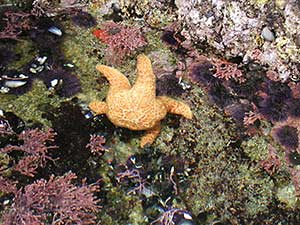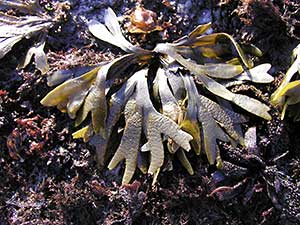Exploring Tide Pools
 Looking for an exciting ocean adventure? Go no further than the sanctuary's rocky shores and tide pools. During low tide, it's a great place to discover sea life without getting wet!
Looking for an exciting ocean adventure? Go no further than the sanctuary's rocky shores and tide pools. During low tide, it's a great place to discover sea life without getting wet!
Tide Pool Life
Meet some of the fascinating plants and animals that survive in this rugged and changing seascape.
Check Tides
Tide pools are best explored at low tide. To choose a good day for tide pooling, use a tide table showing the times and tidal heights of all high and low tides throughout the year. They can be found at a local surfing, boating or other marine related businesses. Or, check NOAA's Tide Predictions. Tides listed in minus feet are the lowest and best for tide pooling. Generally early summer mornings and late fall and winter afternoons have the year's lowest tides.
Tide Pool Locations
The Monterey Bay Sanctuary offers some of the best tide pooling in the world! Learn about a few of the top tide pool locations to visit.
Tide Pool Tips
Although tide pool creatures can survive harsh conditions, human visitors can easily disturb them. A simple act like turning over a rock and exposing the animals to the sun can harm them.
When you visit tide pools, do your part to preserve this special place:
 Step Lightly. Most rocks are covered with living animals and plants. Step carefully to avoid crushing them.
Step Lightly. Most rocks are covered with living animals and plants. Step carefully to avoid crushing them.- Look closely. Sit quietly and watch for a few minutes. You'll see and learn much more this way.
- Touch gently. If you touch an animal or plant, touch it gently.
- Leave everything as you found it. Strict laws govern collecting tide pool life. Enjoy seashore life in its natural environment and leave the plants and animals exactly as you found them.
- Be safe. Keep an eye out for waves, and don't turn your back on the ocean. Wear sturdy shoes or rubber boots that can get wet. Dress in layers and bring sunscreen and sunglasses.
Useful Links
SIMoN
Rocky shore and tide pool information from the Sanctuary Monitoring Network
Site Characterization
Rocky shore and tide pool information from the sanctuary's Site Characterization
LiMPETS
In this field program, students and volunteers are trained to study and monitor the rocky and sandy shores of the marine sanctuary.
Common rocky shore animals and plants of central California
A teaching tool created by Stanford University's Hopkins Marine Station.
